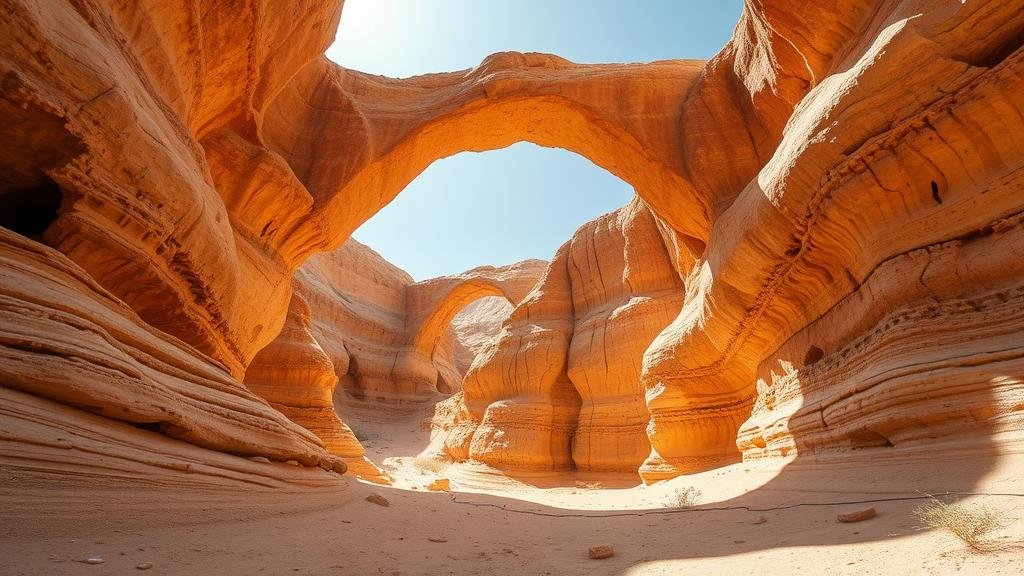Searching for the natural sandstone arches hidden in Algeria’s Tassili n’Ajjer.
Searching for the Natural Sandstone Arches Hidden in Algeria’s Tassili nAjjer
Nestled in the southeastern region of Algeria, the Tassili nAjjer National Park is a marvel of nature, boasting an otherworldly landscape, rich archaeological history, and a treasure trove of natural sandstone arches. This stunning UNESCO World Heritage Site spans over 72,000 square kilometers and features some of the most breathtaking geological formations on earth, making it a prime destination for adventurers and nature enthusiasts alike.
The Origins of Tassili nAjjer
The name Tassili nAjjer translates to Plateau of Rivers in the Tuareg language. The region has a rich geological history that dates back approximately 200 million years. Originally an expansive seabed, tectonic movements have since lifted sedimentary rocks to form the plateau observed today. Over millennia, erosion caused by wind and water has carved out the intricate sandstone arches and unique rock formations that define this dramatic landscape.
Key Natural Attractions
The sandstone arches of Tassili nAjjer are not merely aesthetically pleasing; they also hold immense geological significance. When searching for these natural wonders, you will want to focus on several notable locations:
- Arch of El Atrous: This enormous natural arch is one of the most famous in the region. Measuring over 200 meters long, it presents a striking view set against the rugged terrain.
- Arch of Tassili Rouba: Renowned for its intricate carvings and narrow passageways, this arch provides insight into the artistic expressions of ancient civilizations that once roamed these lands.
- Les Aigles (The Eagles): Named for its eagle-like shape, this arch presents a unique photographic opportunity and a chance to observe local wildlife, such as eagles and other birds of prey.
Archaeological Significance
The Tassili nAjjer region is also known for its rich archaeological findings, including rock engravings that date back to the Neolithic era. These petroglyphs provide a glimpse into the lives of prehistoric peoples and demonstrate that the area was once lush and fertile before it transformed into the arid landscape witnessed today. Science has documented over 15,000 engravings depicting animals, human figures, and geometric shapes, offering invaluable insight into early human civilization and their interactions with the environment.
Visiting the Sandstone Arches
To explore the natural arches of Tassili nAjjer, visitors typically embark on guided tours, as the region is remote and can be challenging to navigate without expert knowledge. Key starting points for exploration include:
- Ali Sidi: This small village serves as the primary access point for those wishing to delve into the park. From here, several guided tours can be arranged.
- Tamanrasset: As the nearest major town, Tamanrasset is essential for logistics and offers various accommodations for travelers.
Considering the harsh desert environment, it is crucial for visitors to prepare adequately. Essential items include:
- Sturdy hiking boots suitable for rugged terrain
- Ample water supply and hydration packs
- Sun protection including hats, sunglasses, and sunscreen
- A map or GPS device to navigate the expansive area
Preservation Efforts and Challenges
Despite its natural beauty, the Tassili nAjjer region faces several challenges, including environmental degradation due to climate change and human activities. In recent years, local authorities and conservation groups have worked diligently to implement sustainable tourism practices to protect the fragile ecosystems and maintain the integrity of the archaeological sites.
Actionable Takeaways
For those captivated by the allure of Algerias Tassili nAjjer, consider the following actionable steps:
- Plan your trip during the cooler months (October to April) to avoid extreme desert temperatures.
- Engage with local tour guides to not only foster community support but also gain deeper insights into the history and ecology of the region.
- Follow Leave No Trace principles to minimize your environmental impact while exploring this beautiful landscape.
In summary, the aventurine-like sandstone arches of Tassili nAjjer are a testament to natures artistry and the rich historical narratives threaded through the region. They beckon explorers seeking adventure and a connection to the ancient past, reminding us of the delicate balance between preservation and discovery.



